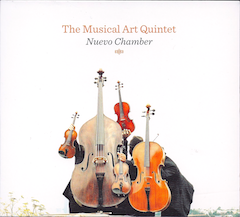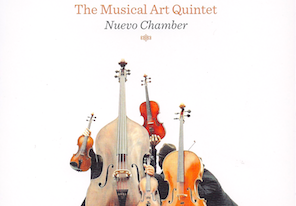
Given that SFCV’s September calendar includes multiple performances by the San Francisco–based Musical Art Quintet, it’s about time that we took a listen to its 2011 debut CD, Nuevo Chamber. The ensemble, which coalesced in 2008 during weekly Sunday-night jam sessions at Café Revolution, is but one of several organizations that, having developed during the early days of the Classical Revolution movement in San Francisco, are taking part in this month’s Classical Revolution Music Festival in San Francisco, Santa Cruz, and Berkeley.
The CD contains 12 pieces/songs/numbers, most of which “MAQ band leader,” bassist/guitarist/keyboard player Sascha Jacobsen composed for Classical Revolution’s weekly gatherings, and that were often performed with “ink still wet.” While Jacobsen is the great-grandson and namesake of violinist/composer/Juilliard School of Music pedagogue Sascha Jacobsen, who in the 1940s formed the Musical Art Quartet at what later became the Juilliard School (misspelled on the album cover), his Latin-tinged music sounds far more Ástor Piazzolla-lite than Schubert or Brahms.
Listen To The Music
Milonga de San FranciscoOmbligao En Argentina (English Version)


Take the opening track, “Milonga de San Francisco,” for example. Perhaps this tango’s beguiling rhythms, pleasingly accessible harmonies, spicy tinge, and lush middle section were what inspired one member of the local press to hype the CD as proof that “classical music is sexy again.” It’s certainly a lot of fun, especially with the occasional sounds of South American noisemakers thrown in, and it just might encourage you to trade your concert hall attire for tight pants or a high-slit gown and a comfortable pair of dancing shoes.
You’ll likely love this disc as long as you’re not too disturbed by what I presume to be first violinist Anthony Blea’s bright, steely sweet timbre, which gives the music an extra zing without ever blending in with the other instruments, and as long as you don’t demand that music communicate on multiple emotional levels — in other words, if you’re happy with classical Latin crossover that sounds like the flip side of what Quartet San Francisco often performs, and if you’re a glutton for catchy tunes that convey a single thought or emotion.
You’ll likely love this disc … if you’re happy with classical Latin crossover that sounds like the flip side of what Quartet San Francisco often performs.
Figures like the extra bright “zing zing zing” of the violin at the start of “Luna Llena” (Full moon) or the colorful sounds of what I presume to be guitar, bongo, and other instruments in “Fela Feliz” (Happy fella) only add to the fun, and distract from the lively sameness of tunes that ask for little while giving mucho alegría in return.
There’s also a lot of beauty, certainly in “Paddies,” by Malagasy guitarist Solorazaf, though I again wish that the first violin weren’t so bright and insistent. And lest you think that all the music is light, the poet and Latin American jazz mainstay Avotjca — a Bay Area treasure — contributes some powerful poetry about dancing in the shadow of slavery on Jacobsen’s spicy and intriguing “Ombligao en Argentina.” I don’t know why the electronic passages and violinist Jory Fankuchen’s opening cadenza, heard in the Spanish-language version, are removed from the English-language bonus track, let alone why the sound engineer partially submerged Avotjca’s evocative voice amid the quintet, but it’s still a great track among many.

